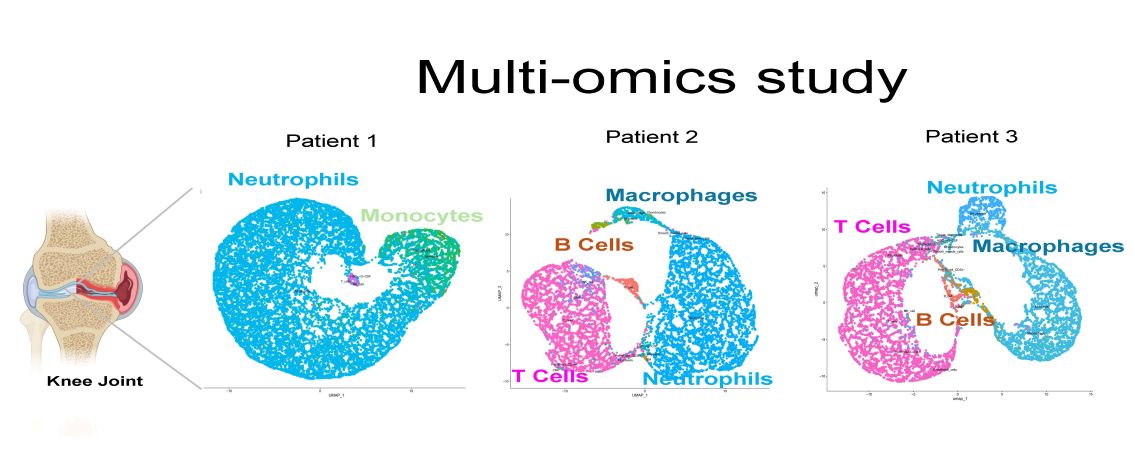Rapid multi-omics test offers breakthrough in diagnosing pediatric joint infections
UTSW study shows advanced genetic and immune profiling can swiftly distinguish septic arthritis from autoimmune conditions, potentially sparing children unnecessary antibiotics

A small-scale clinical study from UT Southwestern found that a combination of tests can quickly and accurately diagnose septic arthritis in children with joint pain. This approach, called multi-omics, looks for bacterial DNA, inflammatory agents, and antibodies produced by the body.
This three-pronged rapid test can also quickly distinguish between arthritis – or joint inflammation – caused by an infection or by an autoimmune response in which the immune system mistakenly attacks the body’s own tissues. Use of this test could spare children from unnecessary antibiotics, the researchers said.
“We’re looking at the pathogen, but we’re also looking at the host,” said Prithvi Raj, Ph.D., senior author of the study and Associate Professor of Immunology and Director of the Microbiome Research Laboratory, Genomics Core facility, and Microarray and Immune Phenotyping Core facility at UT Southwestern.
The study, published in Pediatric Rheumatology, involved a dozen children, ages 3 months to 12 years, who had already gone through standard clinical diagnostics and treatments for septic arthritis. Multi-omics testing of knee joint fluid showed that six of the children had bacterial infections, two had autoimmune arthritis, and one had joint pain from a previous infection.
“These are pretty practical tests,” Dr. Raj said.
Septic arthritis occurs when a joint is infected with Streptococcus, Staphylococcus, or other pathogens. While this condition affects less than 1% of children, it can severely damage joints.
Diagnostic testing for septic arthritis typically involves blood work, DNA testing, and culturing joint fluid for bacteria. However, these tests are time-consuming and oftentimes inconclusive. A recent study found that about 10% of children treated for bacterial arthritis were later found to have noninfectious conditions.
“This indicates that unnecessary invasive procedures and antibiotic treatment courses occurred,” the authors concluded in the article.

In the Pediatric Rheumatology study, researchers tested the joint fluid samples using metagenomics next-generation sequencing (mNGS), an advanced technology available at UT Southwestern’s Microbiome Core facility, to determine microbial DNA/RNA sequences in a variety of sample types from patients with infectious syndromes. To identify the bacterial species, they sequenced a section of bacterial ribosomal RNA called 16s rRNA gene. They also measured the levels of 48 immune-related proteins known as cytokines/chemokines and antibodies in the joint fluid. These parameters help characterize patients’ immune responses and can distinguish between an ongoing bacterial or viral infection and an autoimmune condition in such cases.
The six children with active infections were found to have Streptococcus pyogenes or Staphylococcus aureus in their joint fluid and elevated levels of immune signaling proteins called cytokines. On the other hand, children without any active infection showed low levels of cytokines but elevated autoimmune antibodies in their joint fluid.
The multi-omics approach needs further large-scale testing but shows great clinical promise, Dr. Raj said.
“The cytokine data clearly distinguished children with and without bacterial infection,” he said. “It shows they should not have received antibiotics, and they might not have had to wait two or three months to get to the rheumatologist.”
The study showed that the multi-omics test provided results within 48 hours – a significant improvement over current clinical methods for detecting bacteria in the blood, which often take 48 to 72 hours or more, especially when only small amounts of bacteria are present.
Disease diagnosis and patient enrollment aspects of the study were led by Lawson A. Copley, M.D., Professor of Orthopaedic Surgery and Pediatrics at UTSW and Director of the Musculoskeletal Infection Program at Children’s Health. Additional UTSW researchers contributing to the study included Yolanda Pena-Lopez, Ph.D., Senior Researcher; Bo Zhang, M.S., Lab Manager; Carlos Arana, M.S., Computational Biologist; and Yang Liu, Ph.D., Research Scientist; all from the Microbiome Core; Indu Raman, M.S., Lab Manager; Pratibha Selvakumar, M.S., Research Associate; and Chengsong Zhu, Ph.D., Biostatistical Consultant; all from the Microarray Core.
Other UTSW contributors were Naureen Tareen, M.P.H., Program Manager in Orthopedic Administration; Nicolai van Oers, Ph.D., Professor of Immunology, Microbiology, and Pediatrics; Simrat Morris, M.D., Assistant Professor of Pediatrics; and Lora Hooper, Ph.D., Chair and Professor of Immunology and a Howard Hughes Medical Institute Investigator.
The study was funded by a Hartwell Foundation grant to Dr. Raj.
Endowed Titles
Dr. Hooper holds the Jonathan W. Uhr, M.D. Distinguished Chair in Immunology and is a Nancy Cain and Jeffrey A. Marcus Scholar in Medical Research, in Honor of Dr. Bill S. Vowell.

